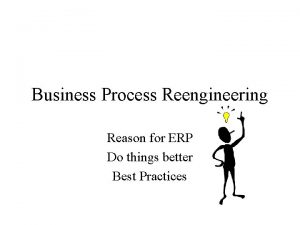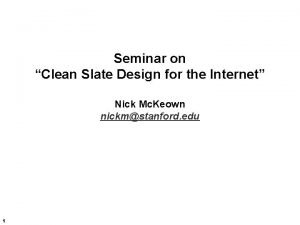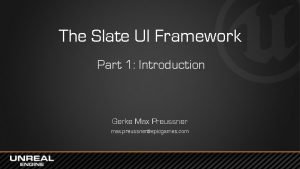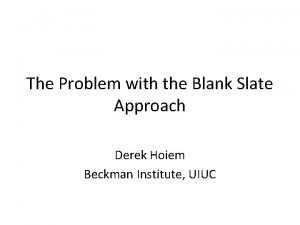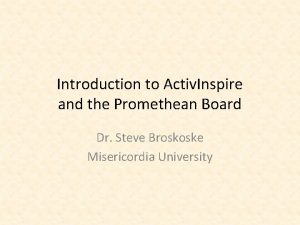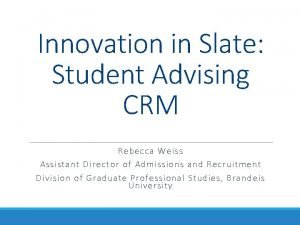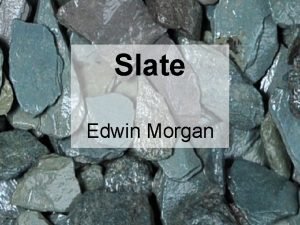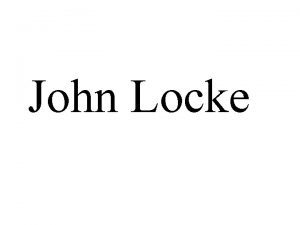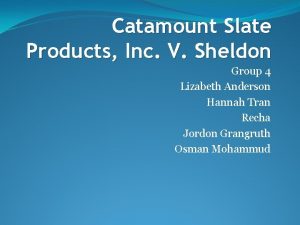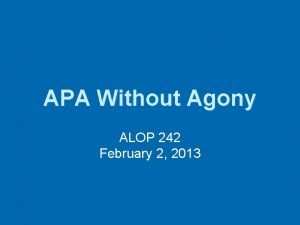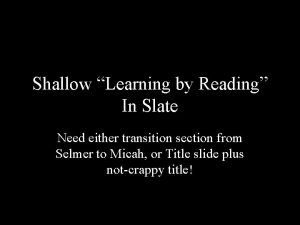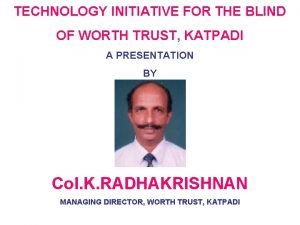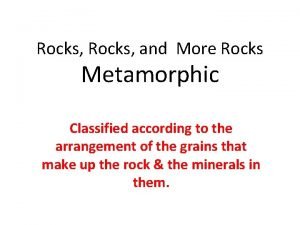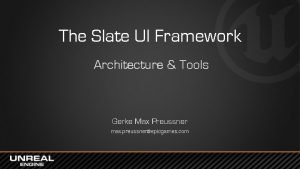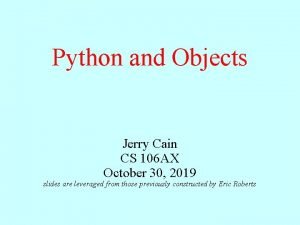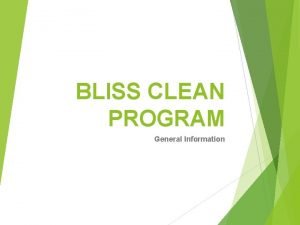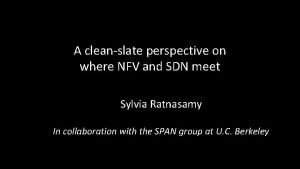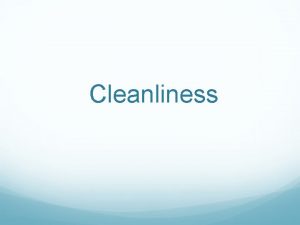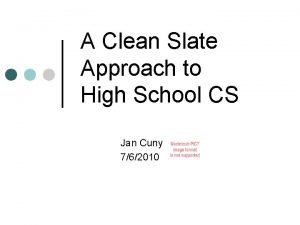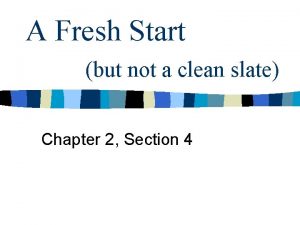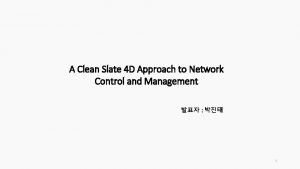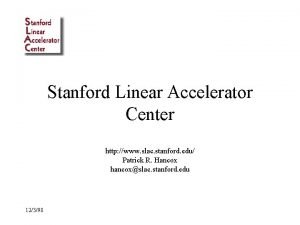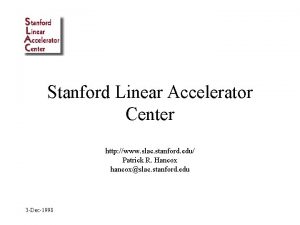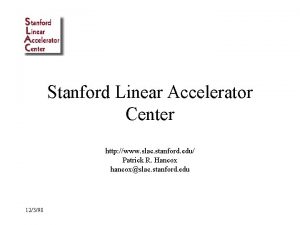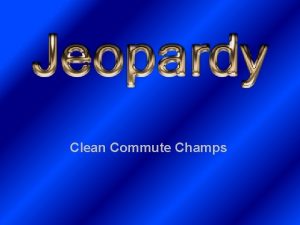The Stanford Clean Slate Program http cleanslate stanford
































- Slides: 32

The Stanford Clean Slate Program http: //cleanslate. stanford. edu Nick Mc. Keown Professor of Computer Science & Electrical Engineering The Stanford Clean Slate Program http: //cleanslate. stanford. edu

“These guys are completely on crack “It doesn't…You need do fixing. just to needs not It want haveaintelligence few upgrades. IPV 6 the would be a nice inside network, ever… The place to start” [network] should be applicationunaware, stupid, unreliable, and as simple as possible. Which is the Internet we have today, and it works great, thank you very much. ” It’s just a bunch of tubes, right? The Stanford Clean Slate Program http: //cleanslate. stanford. edu

Clean Slate Research is… A way of thinking … that is common elsewhere … but difficult when there is legacy The Stanford Clean Slate Program http: //cleanslate. stanford. edu

Rethinking the car Installed base 1 gallon of gas g 22 lbs of CO 2 1900 1968 2007 8, 000 170 M 700 M Car Engine Control Fuel Car Body Materials Manufacture Safety The Stanford Clean Slate Program Policy Emissions Fueling Stations http: //cleanslate. stanford. edu

Anything to rethink? “How come it takes an hour to set up a session? ” “Why can I join someone else’s call? ” “Will the quality always be this poor? ” “Can I put a camera on my car and drive around? ” The Stanford Clean Slate Program http: //cleanslate. stanford. edu

Unthought of applications Economically sustainable Trustworthy: Secure, robust, manageable Mobility by default. Users and data Performance to blow our socks off Unthought of links The Stanford Clean Slate Program http: //cleanslate. stanford. edu

Early stakes in the ground Organic growth lead to structure: Let’s exploit it Optics is here to stay: Let’s exploit it too Flows: They are our friends The Stanford Clean Slate Program http: //cleanslate. stanford. edu

In parallel 2005: A sea-change in the networking research community – – Prompted by NSF ITRs (including 100 x 100 Clean Slate Program) NSF FIND: Funding for architectural ideas NSF GENI: Creating a platform for experimenting with new architectures, services and technologies 2006 -2007: A large community-wide effort – GENI planning process – Programs starting in Europe and Asia 2007 - : GENI Project Office The Stanford Clean Slate Program http: //cleanslate. stanford. edu

Bottom-up first, Top-down later v Now…“Innovation in the small” Architectural v Coverage of areas Blueprint? v Four funded so far, adding more The Stanford Clean Slate Program http: //cleanslate. stanford. edu

Flagship projects v Larger collaborative projects Architectural v Start to tie research together Blueprint? The Stanford Clean Slate Program http: //cleanslate. stanford. edu

Top-down blueprint? Too early to decide Architectural Blueprint? Programmable Nationwide Backbone (Lightflow) Flow Theory The Stanford Clean Slate Program Local Wireless Platform Security (Ethane) Wireless (Spectrum) Backbone (VLB) Congestion Control (RCP) http: //cleanslate. stanford. edu

The Stanford Clean Slate Program v Create a breeding ground for new collaborative projects across boundaries v Projects that will have significant impact in 10 -15 years Exploit Stanford’s breadth and depth v Work closely with a focused group of committed industrial partners v The Stanford Clean Slate Program http: //cleanslate. stanford. edu

Stanford Clean Slate Program Faculty Directors Executive Director Nick Mc. Keown Bernd Girod Guru Parulkar Affiliate Members Cisco NEC Xilinx Deutsche Telekom NTT Do. Co. Mo + 3 in the works The Stanford Clean Slate Program http: //cleanslate. stanford. edu

Stanford’s Breadth and Depth v World-class expertise in: Networking, optical communications, wireless, access networks, theory, economics, security, applications, multimedia, operating systems, hardware and VLSI, system architecture, … v Participants from across EE, CS, MS&E, GSB Dan Boneh, David Cheriton, Bill Dally, Abbas El Gamal, Bernd Girod, Ashish Goel, Andrea Goldsmith, Mark Horowitz, Ramesh Johari, Joseph Kahn, Sunil Kumar, David Mazières, Nick Mc. Keown, David Miller, Phil Levis, Balaji Prabhakar, Mendel Rosenblum, Tim Roughgarden. The Stanford Clean Slate Program http: //cleanslate. stanford. edu

Projects Professors Leonid Kazovsky & Nick Mc. Keown Optical technology promises enormous capacity & low-power Goal is to propose new networks to exploit optical switching Programmable Nationwide Backbone (Lightflow) Flow Theory The Stanford Clean Slate Program Local Wireless Platform Security (Ethane) Wireless (Spectrum) Backbone (VLB) Congestion Control (RCP) http: //cleanslate. stanford. edu

Projects Professors Balaji Prabhakar & Amin Saberi Existing theory lacks details of flow-dynamics and end-to-end semantics Goal is to develop flow-level theoretical models Programmable Nationwide Backbone (Lightflow) Flow Theory The Stanford Clean Slate Program Local Wireless Platform Security (Ethane) Wireless (Spectrum) Backbone (VLB) Congestion Control (RCP) http: //cleanslate. stanford. edu

Projects Professors Andrea Goldsmith & Ramesh Johari Spectrum scarcity is a result of tight, inefficient government control Goal is to propose new approach to spectrum allocation & protocols Programmable Nationwide Backbone (Lightflow) Flow Theory The Stanford Clean Slate Program Local Wireless Platform Security (Ethane) Wireless (Spectrum) Backbone (VLB) Congestion Control (RCP) http: //cleanslate. stanford. edu

Projects Professors Boneh, Mazieres, Rosenblum, Mc. Keown Goal is to propose clean slate architectures for secure networks Programmable Nationwide Backbone (Lightflow) Flow Theory The Stanford Clean Slate Program Local Wireless Platform Security (Ethane) Wireless (Spectrum) Backbone (VLB) Congestion Control (RCP) http: //cleanslate. stanford. edu

What we’d like Principle 1: Manage network using policy over real names “Nancy can access Payroll” “Laptops can’t accept incoming connections” “Vo. IP phones mustn’t move” Payroll Principle 2: Policy should dictate the path packets follow “CEO traffic should not pass through engineering” “Guest flows must pass through http proxy” “Laptop flows must pass through IDS” Principle 3: The origin of packets should be known Principle 4: Network should log all connectivity For diagnostics and auditing Nancy The Stanford Clean Slate Program http: //cleanslate. stanford. edu

Principle 1: Manage network using policy over real names “Nancy can access Payroll” “Laptops can’t accept incoming connections” “Vo. IP phones mustn’t move” Today “Everyone who is not Nancy cannot access payroll” Q: How to identify them? Q: Where do their packets flow? dns Payroll Host: a IP: i MAC: m ACL: Jen’s IP, payroll dhcp learning spanning tree ospf ACL: Jim’s IP, payroll ACL: Jen’s IP, payroll Jen The Stanford Clean Slate Program Nancy Host: b IP: j MAC: n http: //cleanslate. stanford. edu

Problems Nancy Host: b IP: j MAC: n Dynamic bindings v Allocated elsewhere v Not authenticated v Easily spoofed v dns dhcp Bindings between users, hosts and addresses keep changing, are not authenticated and are chosen elsewhere. v Route is picked elsewhere and is unknown to the manager. And changes. v New entities require many more filters. Change of entity locations requires updating of filters. v Easy to circumvent, hard to diagnose. v The Stanford Clean Slate Program http: //cleanslate. stanford. edu

Ethane: Design choices v Centralized management v Policy language governs network v All communication requires permission v Secure and track all bindings The Stanford Clean Slate Program http: //cleanslate. stanford. edu

Ethane: Taking Control controller dns Payroll Host: a IP: i MAC: m “Nancy can access Payroll” “Laptops can’t accept incoming connections” “Vo. IP phones mustn’t move” “CEO traffic should not pass through engineering” “Guest flows must pass through http proxy” “Laptop flows must pass through IDS” dhcp learning spanning tree ospf Nancy The Stanford Clean Slate Program Host: b IP: j MAC: n http: //cleanslate. stanford. edu

Waypoints controller Payroll “Nancy can access Payroll” “Laptops can’t accept incoming connections” “Vo. IP phones mustn’t move” “CEO traffic should not pass through engineering” “Guest flows must pass through http proxy” “Flows to Payroll must pass through IDS” Nancy The Stanford Clean Slate Program http: //cleanslate. stanford. edu

Ethane: Manageability v Fine-grain control of each flow v Can isolate users, groups, hosts v Can specify waypoints v Can require different forms of authentication for different access points (e. g. stronger for wireless than wired) The Stanford Clean Slate Program http: //cleanslate. stanford. edu

Ethane: Many questions v Central controller – Performance & Scalability – Robustness v How to make it easy to use for manager… v …and transparent to user. The Stanford Clean Slate Program http: //cleanslate. stanford. edu

Our deployment v 300+ hosts at Stanford: Servers, laptops, desktops, phones. v 19 switches – Hardware, software, wireless v Policy: 132 rules to replicate policy The Stanford Clean Slate Program http: //cleanslate. stanford. edu

Lessons so far… Controller handles >10, 000 flows/second v Maybe enough for whole of campus v Multiple ways to handle redundancy v – Cold-standby, hot-standby, stateless, stateful Transparent to users (even remotely at home!) v Diagnostics v – Control who can perform diagnostics and see traffic – Journal all bindings: Can tell who sent a packet when. The Stanford Clean Slate Program http: //cleanslate. stanford. edu

Flagship Projects #1: Build our own small private programmable backbone The Stanford Clean Slate Program http: //cleanslate. stanford. edu

Open Source “Router Kit” Routing Control & Mgmt Hardware Datapath Software: Linux/XORP (ICSI) Hardware: Net. FPGA (Stanford) Net. FPGA is a PCI card Net. FPGA is a Programmable 4 x 1 GE “switch” or any packet processor v Program in Verilog v Industry-standard design flow v Contains embedded CPUs v ~$500 for kit v Available June 2007 v For classroom & research Used in CS 344/EE 384 D “Build an Internet Router” and EE 109 The Stanford Clean Slate Program http: //cleanslate. stanford. edu

How would you like to take part? Architectural Blueprint? Programmable Nationwide Backbone (Lightflow) Flow Theory The Stanford Clean Slate Program Local Wireless Platform Security (Ethane) Wireless (Spectrum) Congestion Control (RCP) http: //cleanslate. stanford. edu Backbone (VLB)

Agenda v 09: 00 - 09: 45 Nick Mc. Keown Introduction v 09: 45 - 10: 30 Jonathan Turner, WUSTL An Architecture for a Diversified Internet v 10: 30 - 11: 00 Break v 11: 00 - 11: 30 Bernd Girod Clean Slate Design for Internet Video Delivery v 11: 30 - 12: 00 Balaji Prabhakar 21 st Century Queuing Theory, and Internet Address Allocation The Stanford Clean Slate Program v 12: 00 – 13: 30 Lunch with Poster Session v 13: 30 - 14: 00 William B. Norton, Equinix Video Internet: The Next Wave of Massive Disruption to the U. S. Peering Ecosystem v 14: 00 - 14: 30 Dan Boneh A Clean Slate Approach to Web Technology v 14: 30 - 15: 00 John Mitchell Security Analysis of Network Protocols v 15: 00 - 16: 00 PANEL (Moderated by Balaji Prabhakar) It's Not Just About the Plumbing http: //cleanslate. stanford. edu
 Clean slate reengineering
Clean slate reengineering Clean slate design
Clean slate design Clean up everybody let's clean up
Clean up everybody let's clean up Slate framework
Slate framework Blank slate approach
Blank slate approach Tasman chemicals stone shield
Tasman chemicals stone shield Activ expression
Activ expression Slate student crm
Slate student crm Sedimentary rocks leaving cert
Sedimentary rocks leaving cert Slate edwin morgan
Slate edwin morgan Jean jacques rousseau blank slate
Jean jacques rousseau blank slate Catamount slate products v sheldon
Catamount slate products v sheldon Slate citation machine
Slate citation machine Shallow reading
Shallow reading The worth trust
The worth trust Whats the parent rock of slate
Whats the parent rock of slate How are metamorphic rocks classified
How are metamorphic rocks classified Slate ui framework
Slate ui framework Jerry cain slate
Jerry cain slate Sample monologue
Sample monologue Deqms sdmp
Deqms sdmp San joaquin county electric car rebate
San joaquin county electric car rebate Clean program snacks
Clean program snacks Http //mbs.meb.gov.tr/ http //www.alantercihleri.com
Http //mbs.meb.gov.tr/ http //www.alantercihleri.com Http //pelatihan tik.ung.ac.id
Http //pelatihan tik.ung.ac.id Hình ảnh bộ gõ cơ thể búng tay
Hình ảnh bộ gõ cơ thể búng tay Slidetodoc
Slidetodoc Bổ thể
Bổ thể Tỉ lệ cơ thể trẻ em
Tỉ lệ cơ thể trẻ em Voi kéo gỗ như thế nào
Voi kéo gỗ như thế nào Tư thế worms-breton
Tư thế worms-breton Chúa yêu trần thế
Chúa yêu trần thế Các môn thể thao bắt đầu bằng từ đua
Các môn thể thao bắt đầu bằng từ đua
